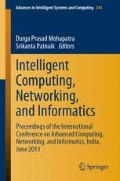Abstract
Coverage in wireless sensor networks has been an area of interest in recent years. Energy efficiency is also very crucial factor to extend the lifetime of wireless sensor network. In wireless sensor network, main source of energy consumption is sensing and communication. In this paper, we model the coverage problem as multi-objective optimization problem for maximizing the lifetime of network and minimizing the energy consumption while keeping the coverage as a quality of service measure. The network lifetime maximization can be achieved by maximizing the number of cover sets while keeping the desired coverage fraction. We use NSGA-II an evolutionary multi-objective approach to solve this problem successfully.
Access this chapter
Tax calculation will be finalised at checkout
Purchases are for personal use only
References
Akyildiz, I.F., Su, W., Sankarasubramaniam, Y., Cayirci, E.: Wireless sensor networks: a survey. Comput. Netw. 38(4), 393–422 (2002)
Meguerdichian, S., Koushanfar, F., Potkonjak, M., Srivastava, M.B.: Coverage problems in wireless ad-hoc sensor networks. IEEE Inf. 3, pp. 1380–1387 (2001)
Shih, E., Cho, S., Ickes, N., Min, R., Sinha, A., Wang, A., Chandrakasan, A.: Physical layer driven protocol and algorithm design for energy-efficient wireless sensor networks, In: Proceedings of the 7th International Conference on Mobile Computing and Networking, Rome, Italy, pp. 272–287 (2001)
Deng, J., Han, Y. S.,. Heinzelman, W. B., Varshney, P. K.: Scheduling Sleeping nodes in high density cluster-based sensor networks, ACM/Kluwer mobile networks and applications, special issue on “energy constraints and lifetime performance in wireless sensor networks”. Mob. Netw. Appl. 10(6), pp. 825–835 (2005)
Slijepcevic, S., Potkonjak, M.: Power efficient organization of wireless sensor networks. In: Proceedings of IEEE International Conference on Communication, Helsinki, Finland, pp. 472–476 (2001)
Paul, S., Nandi, S., Singh, I.: A dynamic balanced-energy sleep scheduling scheme in heterogeneous wireless sensor network, ICON 2008. 16th IEEE International Conference, pp. 1–6, 12–14 Dec 2008
Tian, Di., Georganas, Nicolas D.: A coverage-preserving node scheduling scheme for large wireless sensor networks. In: Proceedings of the 1st ACM International Workshop on Wireless Sensor Networks and Applications, ACM, New York, USA, pp. 32–41 (2002)
Martins, F.V.C., Carrano, E.G., Wanner, E.F., Takahashi, R.H.C., Mateus, G.R.: A hybrid multiobjective evolutionary approach for improving the performance of wireless sensor networks. Sens. J. IEEE 11(3), 545–554 (2011)
Tilak, S., Abu-Ghazaleh, N B., Heinzelman, W.: Infrastructure tradeoffs for sensor networks, In: 1st ACM International Workshop on Wireless Sensor Networks and Applications (WSNA’02), pp. 49–58 (2002)
Xu, Y., Heidemann, J., Estrin, D.: Geography-informed energy conservation for ad hoc routing. In: Proceedings of the 7th Annual ACM/IEEE International Conference on Mobile Computing and Networking (MobiCom’01), Rome, Italy, July 2001
Zhang, H., Hou, J.C.: Maintaining sensing coverage and connectivity in large sensor networks, Technical Report UIUC, UIUCDCS-R- 2003-2351 (2003)
Jia, J., Wu, X., Chen, J., Wang, X.: Exploiting sensor redistribution for eliminating the energy hole problem in mobile sensor networks. EURASIP J. Wirel. Commun. Netw. 1, 1–11 (2012)
Deb, K., Pratap, A., Agarwal, S., Meyarivan, T.: A fast and elitist multi-objective genetic algorithm: NSGA-II. IEEE Trans. Evol. Comput. 6(2), 182–197 (2002)
Author information
Authors and Affiliations
Corresponding author
Editor information
Editors and Affiliations
Rights and permissions
Copyright information
© 2014 Springer India
About this paper
Cite this paper
Sagar, A.K., Lobiyal, D.K. (2014). A Multi-Objective Optimization Approach for Lifetime and Coverage Problem in Wireless Sensor Network. In: Mohapatra, D.P., Patnaik, S. (eds) Intelligent Computing, Networking, and Informatics. Advances in Intelligent Systems and Computing, vol 243. Springer, New Delhi. https://doi.org/10.1007/978-81-322-1665-0_32
Download citation
DOI: https://doi.org/10.1007/978-81-322-1665-0_32
Publisher Name: Springer, New Delhi
Print ISBN: 978-81-322-1664-3
Online ISBN: 978-81-322-1665-0
eBook Packages: EngineeringEngineering (R0)

